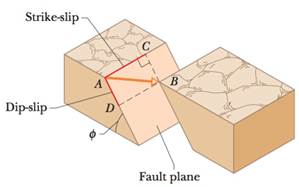
Concept explainers
Rock faults are ruptures along which opposite faces of rock have slid past each other. In Fig. 3-35, points A and B coincided before the rock in the foreground slid down to the right. The net displacement

Figure 3-35 Problem 51.
Want to see the full answer?
Check out a sample textbook solution
Chapter 3 Solutions
Fundamentals of Physics Extended
Additional Science Textbook Solutions
College Physics
College Physics: A Strategic Approach (3rd Edition)
Modern Physics
Conceptual Physics (12th Edition)
Mathematical Methods in the Physical Sciences
Lecture- Tutorials for Introductory Astronomy
- What surface is represented by r a = const, that is described if a is a vector of constant magnitude and direction from the origin and r is the position vector to the point P(x1, x2, x3) on the surface?arrow_forwardWhat is wrong with the following expressions? How can you correct them? (a) C=AB , (b) C=AB , (c) C=AB , (d) C=AB , (e) C+2A=B , (f) C=AB , (g) AB=AB , (h) C=2AB , (i) C=A/B , and (j) C=A/B .arrow_forwardThe density of a spherical solid at a point P = (x, y, z) is given by f(x, y, z) = c(x² + y² + z²) , c it is a positive constant. When attempting a displacement from the point P = (1,2,3) of the interior of this solid, according to the vector below: a = (1, 1/2, -1) The density trend is: A) decrease B) increase to the maximum C) keep constant D) decrease to the maximum E) increasearrow_forward
- (c) The angle that F2 makes with the positive r axis is found from tan0 = Fay/F2z = 21/32% 0.656. Consequently, the angle is either 33° or 33° + 180° = 213°. Since both the r and y components are negative, the correct result is 213°. Please explain how you find that the angle equals 33. Thank you.arrow_forwardIf =- 3;-63+ 1kand č= - 33 - 23- 3g, what is the magnitude of č x B (give your answer to the nearest 0.1)?arrow_forwardI had asked this question earlier but was not satisfied with the execution of the answer. Is there any way you could wright down the answer instead of typing it :) The answer should be 1.9 x 10^-8 A but unsure how to get there. I have attached the question. Thanksarrow_forward
- (a) Find the curl of the following vector: A =r cos e f-( (sin & cos @ (spherical) (b) Find the divergence of the following vector A = f 2r sin o- @r cos o +2 4r (cylindrical) If u know both subparts then u try otherwise skip for otherarrow_forwardUsing spherical polar coordinates, find Vf for (a) f = r4 (b) f = 2+1 (c) f = r² sin 20 cos oarrow_forwardKindly give me a detailed answer in a clear handwriting of subpart (b). I am attaching the full question but I only need (b). All the questions are related. I only have few minutes kindly give the ans ASAP. I will upvote if the answer is correct and answered soon. Thank you.arrow_forward
- Question 5: (a) From Lesotho Bank tower an object was observed on the ground at a depression o below the horizon. A gun was fired at an elevation a, but the shot missing the object, stuck the ground at a point whose depression was y. Prove that the correct elevation è of the gun is given by sin y (1+ cos(20)) sin o (1+ cos(2w)) sin(20 +0) + sin(o) sin(2a+0) + sin(o) 2arrow_forward16-20 A motorcyclist heads 267 m/s, 35.76° N of W and then it changes its direction heading 46 m/s West before it reaches its destination. Calculate the following: I. value of summation and direction of VxII. value of summation and direction of Vy andIII. The value of resultant vector of velocity and the angle formed A. 262.66 m/s West ; 156.03 m/s North ; 305.51 m/s, 30.71 N of WB. 245.45 m/s North ; 145.02 m/s West ; 385.09 m/s, 39.09 W of NC. 156.23 m/s West ; 58.74 m/s North ; 166.91 m/s, 28.54 N of WD. 178.34 m/s North ; 65.36 m/s West ; 189.94 m/s, 19.34 W of N 21-25 A body is projected with an initial velocity of 25.5 m/s at 30 below the horizontal. Find: I. time of flight II. the maximum height attained by the body III. range A. Time of flight = 1.3s ; Maximum height = 7.7m ; Range = 55mB. Time of flight = 2.5s ; Maximum height = 8.7m ; Range = 60mC. Time of flight = 1.1s ; Maximum height = 6.9m ; Range = 45mD. Time of flight = 2.3s ; Maximum height = 9.7m ; Range = 65marrow_forwardProve A is perpendicular to A×B [Assume A=Ax i + Ay j +Az k, B=Bx i + By j +Bz k]arrow_forward
 Physics for Scientists and Engineers, Technology ...PhysicsISBN:9781305116399Author:Raymond A. Serway, John W. JewettPublisher:Cengage Learning
Physics for Scientists and Engineers, Technology ...PhysicsISBN:9781305116399Author:Raymond A. Serway, John W. JewettPublisher:Cengage Learning University Physics Volume 1PhysicsISBN:9781938168277Author:William Moebs, Samuel J. Ling, Jeff SannyPublisher:OpenStax - Rice University
University Physics Volume 1PhysicsISBN:9781938168277Author:William Moebs, Samuel J. Ling, Jeff SannyPublisher:OpenStax - Rice University Principles of Physics: A Calculus-Based TextPhysicsISBN:9781133104261Author:Raymond A. Serway, John W. JewettPublisher:Cengage Learning
Principles of Physics: A Calculus-Based TextPhysicsISBN:9781133104261Author:Raymond A. Serway, John W. JewettPublisher:Cengage Learning Classical Dynamics of Particles and SystemsPhysicsISBN:9780534408961Author:Stephen T. Thornton, Jerry B. MarionPublisher:Cengage Learning
Classical Dynamics of Particles and SystemsPhysicsISBN:9780534408961Author:Stephen T. Thornton, Jerry B. MarionPublisher:Cengage Learning College PhysicsPhysicsISBN:9781305952300Author:Raymond A. Serway, Chris VuillePublisher:Cengage Learning
College PhysicsPhysicsISBN:9781305952300Author:Raymond A. Serway, Chris VuillePublisher:Cengage Learning An Introduction to Physical SciencePhysicsISBN:9781305079137Author:James Shipman, Jerry D. Wilson, Charles A. Higgins, Omar TorresPublisher:Cengage Learning
An Introduction to Physical SciencePhysicsISBN:9781305079137Author:James Shipman, Jerry D. Wilson, Charles A. Higgins, Omar TorresPublisher:Cengage Learning





